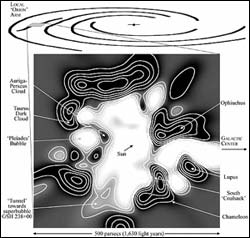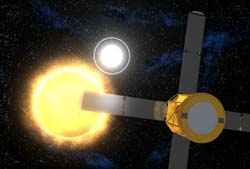Physics and Astronomy
This area deals with the fundamental laws and building blocks of nature and how they interact, the properties and the behavior of matter, and research into space and time and their structures.
innovations-report provides in-depth reports and articles on subjects such as astrophysics, laser technologies, nuclear, quantum, particle and solid-state physics, nanotechnologies, planetary research and findings (Mars, Venus) and developments related to the Hubble Telescope.

Odyssey thermal data reveals a changing Mars
The first overview analysis of a year’s worth of high-resolution infrared data gathered by the Thermal Emission Imaging System (THEMIS) on NASA’s Mars Odyssey spacecraft is opening Mars to a new kind of detailed geological analysis and revealing a dynamic planet that has experienced dramatic environmental change.
The report by THEMIS’s science team will appear in an upcoming issue of Science and will be released on June 5 in the magazine’s online preview, Science Express.
“THEMIS

Clamps away, Mars Express eases its grip on its lander
Europe’s first mission to the Red Planet, continues its successful mission with another successful ’’high-risk’’ post-launch milestone. Mars Express engineers breathed a sigh of relief this morning at the European Space Operations Centre (ESOC), in Germany.
If a particularly delicate operation had not proceeded as planned, it would have been impossible to deploy the Mars Express lander, Beagle 2, on arrival at Mars.
This crucial operation consisted of releasing

UI search for water on Mars set for June 2 launch
NASA-funded project to search for underground water on Mars
University of Iowa professor and space physicist Don Gurnett is hoping to receive an uplifting word from western Asia on Monday.
That’s because Gurnett heads a $7 million, NASA-funded project to search for underground water on Mars, a project whose radar instrument is aboard the European Space Agency’s (ESA) Mars Express spacecraft using a Soyuz rocket and scheduled for launch at 12:45 p.m. CDT Monday, June

New Type of Galaxy Discovered
An international team of astronomers headed by Dr. Michael Drinkwater (Queensland, Australia), Dr. Michael Gregg (Livermore, USA) and Dr. Michael Hilker from the University of Bonn has discovered a new kind of small, very compact galaxy. Their findings will be published in the next edition of the prestigious academic journal Nature on 29th May. This new type of galaxy could help to explain the discrepancy between observations and cosmological models.
The galaxies in our universe are not all

3-D map of local interstellar space shows sun lies in middle of hole piercing galactic plane
The first detailed map of space within about 1,000 light years of Earth places the solar system in the middle of a large hole that pierces the plane of the galaxy, perhaps left by an exploding star one or two million years ago.
The new map, produced by University of California, Berkeley, and French astronomers, alters the reigning view of the solar neighborhood. In that picture, the sun lies in the middle of a hot bubble – a region of million-degree hydrogen gas with 100-1,000 times fewer

RHESSI uncovers secret to cataclysmic explosions known as gamma-ray bursts
University of California, Berkeley’s RHESSI satellite, launched last year by NASA, was snapping X-ray pictures of solar flares in December when it caught an extremely bright background gamma-ray burst, revealing a novel physical feature of these gamma rays – their polarization.
The result sheds new light on the driving force behind these mysterious explosions.
Gamma-ray bursts are mysterious flashes of gamma-ray photons that pop off about once a day randomly in the sky, briefl